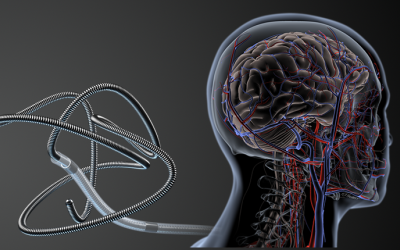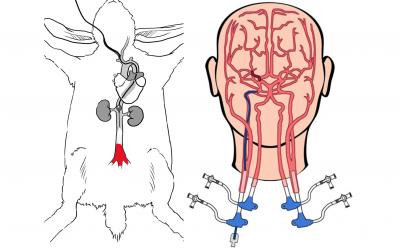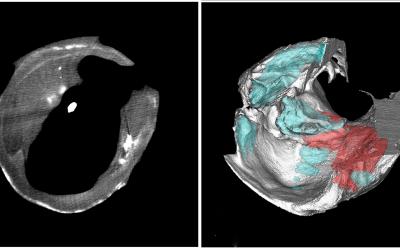
The Science of Mechanical Thrombectomy
Endovascular removal of emboli causing stroke is the new standard of care. Despite high rates of blood flow restoration, 40% of stroke patients still experience poor neurological outcomes, mainly to due incomplete re-opening of the arteries after the first attempt.
The development of new endovascular technologies and techniques that resolve the shortcomings of incomplete recanalization requires more sophisticated testing platforms than the conventional phantom-based simulators.
To understand the relationship between clots and mechanical thrombectomy devices as well as to increase the effectiveness of mechanical thrombectomy procedure, the lab has:
-Conducted mechanistic research to understand the forces driving the interaction between emboli and current stroke thrombectomy devices. The has been done this by analyzing the histological composition and strength of emboli retrieved from patients and evaluating the mechanical forces necessary for their retrieval.
-Generated a library of histologically and mechanically validated emboli analogs derived from human blood to match emboli causing strokes.
-Developed a test bed for mechanical thrombectomy using 3D-printed and commercially available cerebrovascular phantoms with a customized hydraulic system to generate physiological flow rate and pressure and utilizing the clot analogs to mimic embolic occlusion of cerebrovascular arteries.
-Constructed the first-in-kind test bed for embolic occlusion of cerebrovascular arteries and mechanical thrombectomy using cadaveric human brains
-Developed the first-in-kind cadaveric human head and neck model, pressurized under physiological conditions to mimic the cerebrovascular conditions encountered in patients.
These models have been instrumental in the iterative design process of endovascular technologies invented in the lab and have facilitated engagement with industry for preclinical testing of their technologies. These academic-industry partnerships have been instrumental in keeping the TNT Lab at the forefront of medical innovation.
Leveraging the new knowledge about biomechanics in large vessel occlusion (LVO) stroke and the testing platforms, the team has developed an entirely new class of thrombectomy system that ingests emboli by the generation of a unique and powerful whirlpool.
We conducted preliminary computational simulations, prototyping and bench testing of this new device that suggested that this disruptive mechanism could be translated into a new-generation, low-profile and atraumatic thrombectomy technology. Then, by employing the multiple preclinical testing platforms developed in-house including phantoms, human cadaveric models and in vivo translational animal models, we showed that this device had extensive superiority in safety and efficacy compared with commercially available technologies.
This awarded platform technology, protected by multiple granted patents and several more in the pipeline, was licensed to Endovascular Engineering, Inc. Additionally, many other technologies are currently under development in our lab.
Gebrezgiabhier D, Liu Y, Reddy AS, Davis E, Zheng Y, Arturo Larco JL, Shih AJ, Pandey AS, Savastano LE. A human brain test bed for research in large vessel occlusion stroke. https://thejns.org/view/journals/j-neurosurg/aop/article-10.3171-2020.7.JNS202278/article-10.3171-2020.7.JNS202278.xml Journal of Neurosurgery. 2021; doi:10.3171/2020.7.JNS202278.
Liu Y, Reddy A, Cockrum J, Ajulufoh MC, Zheng Y, Shih AS, Pandey AS, Savastano LE. Standardized fabrication method of human-derived emboli with histologic and mechanical quantification for stroke research. https://www.sciencedirect.com/science/article/pii/S1052305720306236?via=ihub Journal of Stroke and Cerebrovascular Diseases. 2020; doi:10.1016/j.jstrokecerebrovasdis.2020.105205.
Reddy A, Liu Y, Cockrum J, Gebrezgiabhier D, Davis E, Zheng Y, Pandey AS, Shih AJ, Savastano LE. Construction of a comprehensive endovascular test bed for research and device development in mechanical thrombectomy in stroke. https://thejns.org/view/journals/j-neurosurg/134/4/article-p1190.xml Journal of Neurosurgery 2021; doi:10.3171/2020.1.JNS192732.
Liu Y, Zheng Y, Reddy AS, Gebrezgiabhier D, Davis E, Cockrum J, Gemmete JJ, Chaudhary N, Griauzde JM, Pandey AS, Shih AJ, Savastano LE. Analysis of human emboli and thrombectomy forces in large vessel occlusion stroke. https://thejns.org/view/journals/j-neurosurg/134/3/article-p893.xml Journal of Neurosurgery. 2021; doi:10.3171/2019.12.JNS192187.
Liu Y, Zheng Y, Li ADR, Liu Y, Savastano LE, Shih AJ. Cutting of blood clots – Experiment and smooth particle Galerkin modelling. https://www.sciencedirect.com/science/article/pii/S0007850619300514?via%3Dihub CIRP Annals. 2019; doi:10.1016/j.cirp.2019.04.025.
Stroke Technology Wins 2019 Biomedical Innovation Cup. https://mmheadlines.org/2019/05/stroke-technology-wins-2019-biomedical-innovation-cup Michigan Medicine News. 2019; https://mmheadlines.org/2019/05/stroke-technology-wins-2019-biomedical-innovation-cup.
Cision PR Newswire. Clot Buster Wins the 35th Annual Pryor-Hale Award at the Michigan Business Challenge. https://www.prnewswire.com/news-releases/clot-buster-wins-the-35th-annual-pryor-hale-award-at-the-michigan-business-challenge-300600886.html 2018; https://www.prnewswire.com/news-releases/clot-buster-wins-the-35th-annual-pryor-hale-award-at-the-michigan-business-challenge-300600886.



